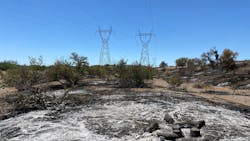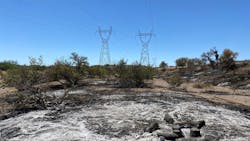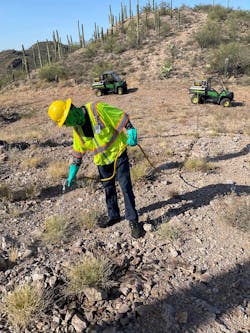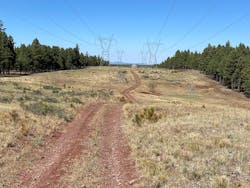Each North American utility must account for its own intrinsic natural landscapes and inherent hazards. In the Western United States, it’s predominantly open spaces in concert with wildfires.
Wildfires are an integral part of most western ecosystems. Unfortunately, a series of wildfires in the early 1900s gave rise to the “Smokey the Bear” mentality labeling wildfires as “bad.” The result was that western ecosystems shifted unnaturally away from historic norms due to aggressive wildfire suppression, which in turn, created catastrophic wildfire events due to the buildup of woody fuels and shade-tolerant vegetation. Global warming has only exacerbated this issue.
For many years now, massive wildfires and the damage they’ve caused has inundated the local and national news. The Desert Southwest has not escaped these events.
Western Area Power Administration’s (WAPA) Desert Southwest region (DSW) has just emerged from its longest wildfire season on record during 2020 without a significant loss of reliability or damage to hardware assets. Unlike previous years, the wildfire season continued unabated through the rest of 2020 and into 2021 due to record-breaking high temperatures that interfered with normal weather patterns and quelled the traditional monsoon season. The heat of last summer was so intense and for such a duration that dozens of regional wildfire alerts were received daily.
Success can be measured in many ways, but in the power industry, the most obvious is reliability and safety. WAPA’s success was realized, in part, based on applying known best management practices (BMPs), along with team collaboration with internal and external stakeholders, to IVM, fuel ladder elimination and fuels reduction.
WAPA’s strategy to attain this accomplishment included:
- Right-of-way (ROW) Assessment and Corrective Actions
- R&D and Application
- Refinement of Actions
- Assessment and Communications
Philosophy
Wildfires serve many functions to keep a given ecosystem healthy, whether to recycle dead or green organic material back into the nutrient cycle, keep the understory clear of growing low-lying vegetation or to remove dead or diseased vegetation.
As students of an ecosystem’s natural processes, it seemed intuitive that the goal for IVM under or adjacent to power lines should not be to attempt to prevent wildfires from entering or passing through a utility easement. Rather, it should be to create the conditions where this natural process can occur with the fewest impacts to utility hardware or energized assets. This would also enhance the environmental stewardship by enabling these natural processes to occur periodically.
North American Electric Reliability Corporation standard FAC-003-4 helps, in part, to remove vegetation that can violate minimum vegetation clearance distances (MVCD) based upon the utility’s IVM strategy. In DSW’s case, a best management strategy of a five-year cycle maintenance plan is currently being implemented across its transmission assets. This means that each circuit would receive some level of IVM every five years as a rule, which would trim or remove incompatible vegetation so it could not regrow into WAPA’s stipulated minimum clearance distance per kilovolt (kV). The goal in establishing a five-year cycle maintenance strategy is to eventually achieve “maintenance mode,” or a low-cost approach to treating remaining vegetation to maintain a low-growing plant community within the wire zone and slightly taller vegetation within the border zone.
ROW Assessment and Corrective Actions (2017-2018)
In Spring 2017, it was apparent DSW might incur an imminent vegetation-related outage or violation of MVCD due to a lack of recent past IVM maintenance. At that time, DSW had no contracting assets and disorganized third-party contractors for inspection. Intense dialogue with DSW’s procurement office helped secure new IVM contractors and leverage third-party contract assets for a 100% ground inspection of all transmission assets in the region.
In addition, DSW used transmission line crew inspections, both ground and aerial with video capture capabilities, to assemble a “hit” list of locations, identified by circuit and span, that required immediate corrective or “hotspot” treatments to gain additional clearance between vegetation and energized assets.
DSW literally reviewed every span to ensure that any clearances that would rise to the level of what WAPA describes as “danger” vegetation clearances were identified and treated immediately.
Research and Development and Application (2018-2020)
Once the year of extensive corrective maintenance was completed, it was time to look at developing a long-range strategy that would place all of DSW’s transmission assets into a levelized cyclic plan. Although this region is mainly known for its slow-growing saguaro cactus and other thorny vegetation, many other plant species can grow within DSW’s easements and create problems. They can not only violate MVCD at a quick rate, such as the century plant, but also, because of the flora’s intrinsic qualities, could create high flame lengths or dark smoke when alit.
WAPA selected a five-year cycle to be applied across DSW. Circuits were assigned priority based on critical path, voltage and the number of known vegetation-related clearance issues. Moving to a scheduled maintenance strategy is less expensive that corrective activities as it eliminates leapfrogging around a system, usually by a factor of five times or greater.
The prescription was refined based on hotspot corrective maintenance performed in the previous year and the remaining reported vegetation-to-conductor clearance issues:
- Remove incompatible vegetation within maintenance clearances per kV within the ROW in all rural areas to the ground and treat all cut stumps of species receptive to herbicide application.
- Remove all fuel ladders down to within five feet of ground level.
- Chip resulting woody debris onto the ROW or haul away when possible.
In urban interphases and based upon easement rights, at a minimum, trim to maintenance clearances per kV. Where opportunities present, buy out vegetation to gain additional clearances.
The assumption in establishing a five-year cycle IVM maintenance program was that more costly corrective maintenance would decrease over the course of time down to a bare minimum per year. In some locations, DSW could not get maintenance clearance due to its easement rights. 2018 saw the initial implementation of this five-year IVM maintenance cycle, also taking advantage of any prior work. The last of the major ROW mastication projects occurred during this year. What was noteworthy about 2017 and 2018 was that the wildfire season wasn’t very serious across DSW’s footprint while it was far more extensive in neighboring California during the same time period.
2019 saw wildfires initiate in consecutive weekends at the beginning of April, which seemed early. The vast majority of fires were human caused, with each passing through the ROWs without incident or damage to the hardware. A retardant drop from one of the wildfires did coat portions of a steel lattice transmission structure and a few feet of the associated conductors. But subsequent inspection for line coronas did not find an issue, concluding that the summer monsoons would wash off the slurry.
Refinement of Actions
The assessment and refinement of application of BMPs occurred during 2019. It was important to take a step back to assess what IVM had been accomplished and how better it could be done.
One of the attributes of DSW’s footprint is that you can’t throw a stone without hitting a cultural site within the ROW. Even though it is labor intensive, hand-cutting is the preferred approach to removing vegetation over mowing or mastication, specifically to protect these cultural sites. Herbicide is also another low impact technique that has become an integral tool in the contractor’s toolbox to attain the desired low-growing plant community.
Incorporating hand-cutting has the principal Phase 2 or ROW reclamation technique to accomplish the target goal. Applying herbicide to cut stumps of those species that react to chemical treatment helped reduce the overall cost of IVM. Then, planning for a follow-up herbicide application one to two seasons afterwards helped not only hold the ROW IVM treatment but also promoted the development of a low-growing plant community.
That’s not to say that all low-growing plants were allowed to remain. Century plants, a member of the agave family, is one of those problematic plant species that can cause an outage in a month. DSW has begun to eliminate all agave from its ROWs. In those places where the circuit’s ground-to-conductor clearance is minimal to engineering specifications, also treating taller yucca, Joshua tree, and saguaro cactus was necessary.
The use of the high-resolution aerial videos three times a year, plus the reports that are submitted by transmission line maintenance crews performing field inspections of DSW’s ROWs, help assure compliance and take advantage of inspections that have to take place regardless.
Assessment and Communications
While experiencing the most extensive and impactive wildfire season seen within DSW’s footprint, no loss of reliability and no significant damage to hardware occurred in 2020.
Minor tweaking of the ROW IVM prescription occurred to include more structure clearing and fireproofing of wooden pole structures with herbicide application and some ground clearing of adjacent vegetation.
Next, WAPA refined the communication not only between its operators located in Phoenix, Arizona, but also ensuring that notifications of these events was disseminated throughout DSW’s staff and contractors. Each field vehicle carried appropriate fire suppression equipment. In addition, training discussed situational awareness or things as simple as not parking over tall dead grass.
DSW also participates in the Southwest Area Coordinating Council, a group of public and private interests that share information and data regarding wildfire suppression and related communications.
The Role of WAPA During Wildfires
In DSW, WAPA monitors wildfire activity to advise firefighting assets and its dispatch of the hazards of any given wildfire burning near or under energized assets. While DSW wants to maintain reliability to its customers, it also wants to ensure the safety of aerial and ground assets. DSW advises the Incident Commander of keeping ground assets at least 100 feet outside of a WAPA ROW and not to hit energized assets with an aerial retardant drop.
The WAPA ground observer also communicates local conditions that may impact reliability directly to WAPA’s Dispatch. If a circuit does relay out, usually from dark smoke, dispatch will want to know this in order to weigh re-energizing the circuit.
Examining the Budget
Every utility will do things its own way depending upon what assets they are protecting as well as their budget and inherent constraints.
While the use of LiDAR and expensive software on ruggedized tablets is one way of accomplished the desired end results, reliability and hardware protection can be accomplished without breaking the bank. But it is equally important to recognize that there is a cost for doing business. It would serve each utility best to identify the right-funding level for what IVM should look like across its assets. Taking short cuts will only come back to haunt those who make that decision.
Steve Narolski ([email protected]) is the Vegetation Program and Access Maintenance Manager for Western Area Power Administration, Desert Southwest region.
About the Author
Steve Narolski
Steve Narolski is the regional IVM program manager for Western Area Power Administration's Desert Southwest region. He has been a professional forester and utility IVM expert for more than 40 years. He has a bachelor's degree in forest science from Pennsylvania State University and is a graduate honorarium in the continuing education in forest ecology and silviculture from Washington State University. He is a licensed registered professional forester in California, a certified forester through the Society of American Foresters, a certified arborist with utility option and Tree Risk Assessment Qualification (TRAQ) certified by the International Society of Arboriculture. He has published multiple professional articles, including a 2010 article for T&D World.




